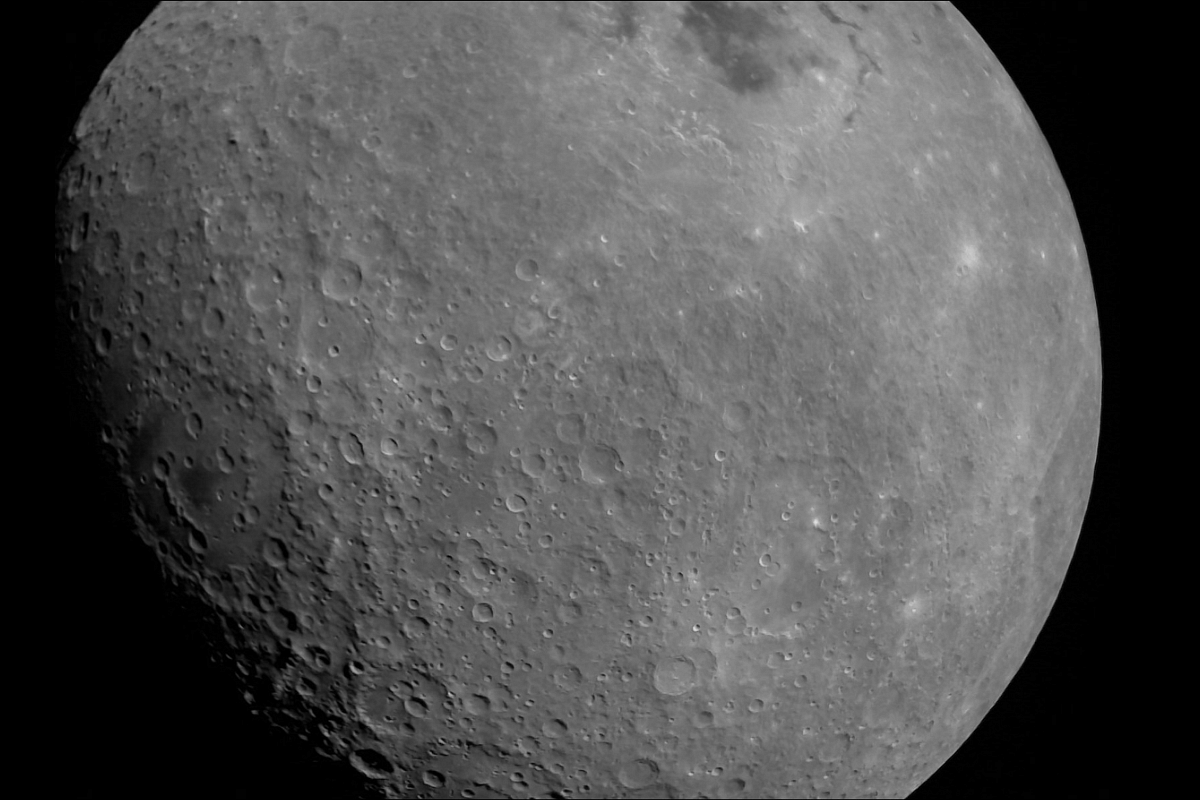Science
Why ISRO’s Confidence In Chandrayaan-3 Soft Landing Is Moon-High
- The ISRO community is exuding tremendous confidence in accomplishing the soft-landing on the Moon that it didn't back in 2019.

The Moon as viewed by Chandrayaan-2 LI4 Camera on 21 August 2019 19:03 UT (satellite altitude: ~ 2,650 km)
The Moon has become a bit of a graveyard for landers in recent times. Rest of the time, the task is so daunting that even attempts are not made.
In all of this century, only China has been able to get its lander down to the lunar surface successfully — three times. The attempts by Israel, India, Japan, and, more recently, Russia have come a cropper.
Close to four years after Chandrayaan-2 failed to stick the landing, and with the next Chandrayaan attempt just under a day away, the Indian Space Research Organisation (ISRO) is confident of achieving a successful result.
Speaking to The Times of India, ISRO Chairman S Somanath said Monday (21 August) that the source of the confidence is all the preparation that went into the mission prior to the launch and, subsequently, the hitch-free progress made so far by the Chandrayaan-3 spacecraft in its journey to the Moon.
Less than a day ahead of the landing, it’s just about the process. “Now, we are preparing for the landing with multiple simulations, verification and double verification of systems, checking of instruments’ health is being done today (Monday) and tomorrow (Tuesday),” Somanath told the daily.
This amazing confidence is neither newfound nor limited to Chandrayaan-3 alone. The ease of manner and occasional laughs are easily visible, for instance, when the top leadership is addressing the gathering at the Satish Dhawan Space Centre-Sriharikota Range (SDSC-SHAR) after a successful launch of, say, a polar satellite launch vehicle (PSLV).
With regards to Chandrayaan-3, however, Somanath said last month, speaking on the sidelines of India Space Congress 2023, that ISRO has adopted a “failure-based design.”
“What all can fail, and how to protect it — this is the approach that we have taken...," he said.
As for what went wrong and how they have rectified it this around, Somanath explained:
"We were trying to target a landing in a particular spot, closer to the South Pole, that is 70 degrees to the South Pole, and in doing so, we faced certain challenges."
The five engines responsible for the retardation, or reduction of the velocity, of the Chandrayaan-2 lander "developed a little higher thrust than that was expected," he said.
This was coupled with the lander's desperation to land at its designated spot even when it was still far away, thereby increasing its velocity, which was already very high, even if still within the specifications.
"So, there was a contradictory requirement of reaching to the exact spot and, at the same time, achieve a low velocity. It became mathematically difficult for it to do it in the available time. So, finally, when it actually did it, it was (sic) fell short of almost half a kilometre and the velocity of touch was higher," the ISRO chief said.
As to what needed to be rectified in Chandrayaan-3, Somanath said, "We found that... we must give more flexibility to the craft to handle dispersions, essentially."
Speaking to ANI on Monday, the former ISRO chairman, K Sivan, who was at the helm during the Chandrayaan-2 mission, said, "Last time, after the landing process, we had gone through the data generated on flight. So, based on that, corrective measures have been taken. Not only that, we did something more than what we corrected. Wherever the margins are less, we enhanced those margins… Based on the lessons we learnt from Chandrayaan 2, this time the system is going with more ruggedness…”
“I am sure this time it will be a grand success,” he declared.
Further, Dr Surendra Pal Singh, a former programme director at ISRO, explained to Republic what’s different — and better — with Chandrayaan-3, once again echoing the assuredness of India’s space agency in striking a definite positive outcome with the Moon landing.
But, perhaps, the strongest expression of confidence thus far has come from the ISRO Chairman himself.
While speaking earlier this month at ‘Chandrayaan-3: Bharat’s Pride Space Mission’, hosted by the non-profit organisation Disha Bharat, Somanath said, “If everything fails, if all the sensors fail, nothing works, still it (Vikram) will make a landing. That’s how it has been designed — provided that the propulsion system works well.”
“We have also made sure that if two of the engines (in Vikram) don’t work this time also, it will still be able to land,” he added.
That’s highly reassuring, if anything is.
Now, with under a day left for Chandrayaan-3 to make that soft landing, making India only the fourth country to do so, and also only the second this century, the genuine wishes of well over a billion people — from India but also globally — are that this amazing confidence translates to an astounding reality for a proud spacefaring nation.
Fingers crossed.
Support Swarajya's 50 Ground Reports Project & Sponsor A Story
Every general election Swarajya does a 50 ground reports project.
Aimed only at serious readers and those who appreciate the nuances of political undercurrents, the project provides a sense of India's electoral landscape. As you know, these reports are produced after considerable investment of travel, time and effort on the ground.
This time too we've kicked off the project in style and have covered over 30 constituencies already. If you're someone who appreciates such work and have enjoyed our coverage please consider sponsoring a ground report for just Rs 2999 to Rs 19,999 - it goes a long way in helping us produce more quality reportage.
You can also back this project by becoming a subscriber for as little as Rs 999 - so do click on this links and choose a plan that suits you and back us.
Click below to contribute.
Latest